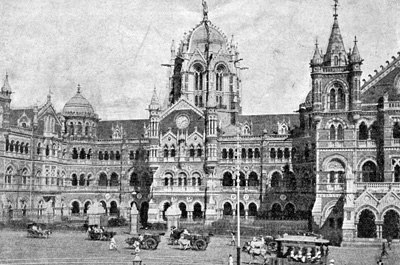History of Mumbai

Following the first war of Independence in 1857, the East India Company was accused of mismanagement, and Bombay reverted to the British crown. With the outbreak of the American Civil War in 1861, and the opening of the Suez Canal in 1869, exports, specially cotton, from Bombay became a major part of the colonial economy.
The Great Indian Peninsular Railway facilitated travel within India. This network of commerce and communication led to an accumulation of wealth. This was channeled into building an Imperial Bombay by a succession of Governors. Many of Bombay's famous landmarks, the Flora Fountain and the Victoria Terminus, date from this time.
The water works, including the Hanging Gardens and the lakes were also built at this time. The Bombay Municipal Corporation was founded in 1872. However, this facade of a progressive and well-governed city was belied by the plague epidemics of the 1890s. This dichotomy between the city's symbols of power and prosperity and the living conditions of the people who make it so continues even today.
The construction of Imperial Bombay continued well into the 20th century. Landmarks from this period are the Gateway of India, the General Post Office, the Town Hall (now the Asiatic Library) and the Prince of Wales Museum. Bombay expanded northwards into the first suburbs, before spreading its nightmare tentacles into the the northern suburbs. The nearly 2000 acres reclaimed by the Port Trust depressed the property market for a while, but the Backbay reclamation scandal of the '20s was a testament to the greed for land.
The freedom movement reached a high pitch of activity against this background of developing Indian wealth. Gandhi returned from South Africa and reached Bombay on January 12, 1915. Following many campaigns in the succeeding years, the end of the British imperial rule in India was clearly presaged by the Quit India declaration by the Indian National Congress on August 8, 1942, in Gowalia Tank Maidan, near Kemp's Corner. India became a free country on August 15, 1947. In the meanwhile, Greater Bombay had come into existence through an Act of the British parliament in 1945.
The seven islands that now form Mumbai were first home to the Koli fisherfolk whose shanties still occupy parts of the city shoreline today. The islands were ruled by a succession of Hindu dynasties, invaded by Muslims in the 14th century and then ceded to Portugal by the Sultan of Gujarat in 1534. The Portuguese did little to develop them before the major island of the group was included in Catherine of Braganza's dowry when she married England's Charles II in 1661. The British Government took possession of all seven islands in 1665 but leased them three years later to the East India Company for a meagre annual rent of 10 pounds sterling.
Bombay soon developed as a trading port thanks to its fine harbour and the number of merchants who were attracted from other parts of India by the British promise of religious freedom and land grants. Migrants included sizeable communities of Parsis and Gujaratis, and south Indian Hindus fleeing Portuguese persecution in Goa. Their arrival, and that of later immigrant groups, laid the basis for Bombay's celebrated multicultural society. Within 20 years, the presidency of the East India Company was transferred to Bombay from Surat, and the town soon became the trading headquarters for the whole west coast of India.
Bombay's fort was built in the 1720s, and soon after land reclamation projects began the century-long process of joining the seven islands into a single land mass. Although Bombay grew steadily during the 18th century, it remained isolated from its hinterland until the British defeated the Marathas and annexed substantial portions of Western India in 1818. Growth was spurred by the arrival of steam ships and the construction of the first railway in Asia from Bombay to Thana in 1853. Cotton mills were built in the city the following year, and the American Civil War - which temporarily dried up Britain's supply of cotton - sparked Bombay's cotton boom. The fort walls were dismantled in 1864 and the city embarked on a major building spree as it sought to construct a civic townscape commensurate with its new found wealth. The opening of the Suez Canal in 1869 and the massive expansion of Bombay's docks cemented the city's future as India's primary port.







